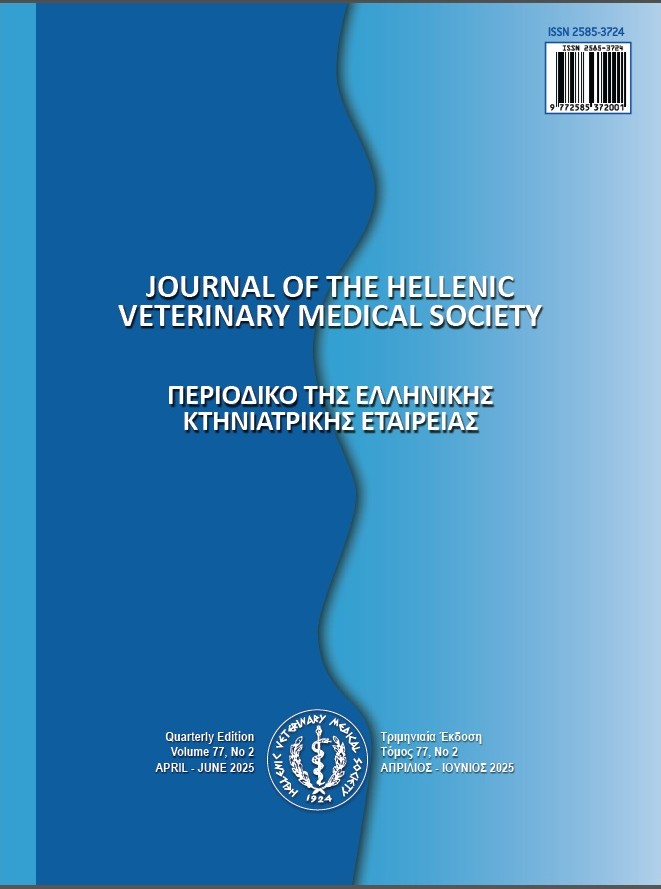The effects of goji berry (Lycium barbarum L.) leaves on performance, meat lipid oxidation, digestive tract parts, and some blood parameters of broiler chickens

Περίληψη
The aim of this study was to investigate the effects of supplementing diets with goji berry (Lycium barbarum L.) leaves (GBL) on performance, meat lipid oxidation, meat chemical composition, carcass traits, some internal organs, digestive tract parts and some blood parameters in broiler chickens. A total of 144 d-old mix-sexed chicks (Ross-308) were weighed and randomly allocated to four experimental groups with three replicates of 12 chickens each. Treatments were as follows: (i) basal diet (control), (ii) basal diet+1 g/kg GBL, (iii) basal diet + 5 g/kg GBL and (iv) basal diet+ 10 g/kg GBL. After analysis of one-way ANOVA, the results revealed that 10 g/kg GBL improved body weight (0-6 weeks) (P<0.01), body weight gain (4-6 weeks) and feed intake (4-6 and 0-6 weeks) (P<0.05). Feed conversion ratio did not significantly improve with GBL treatment (P>0.05). In addition, 10 g/kg GBL of the diet increased heart weight and proventriculus length (P<0.05), however, decreased breast meat lipid oxidation on d 21 (P<0.05). Experimental treatments did not affect the total cholesterol, HDL, glucose and triglycerides (P>0.05) but decreased LDL (P<0.05). In conclusion, supplementation of 10 g/kg GBL to broiler chicken diet may improve performance and may decrease breast meat lipid oxidation and blood serum LDL.
Λεπτομέρειες άρθρου
- Πώς να δημιουργήσετε Αναφορές
-
Arslan Duru, A., & Barıt, M. (2023). The effects of goji berry (Lycium barbarum L.) leaves on performance, meat lipid oxidation, digestive tract parts, and some blood parameters of broiler chickens . Περιοδικό της Ελληνικής Κτηνιατρικής Εταιρείας, 74(2), 5691–5700. https://doi.org/10.12681/jhvms.29995
- Τεύχος
- Τόμ. 74 Αρ. 2 (2023)
- Ενότητα
- Research Articles

Αυτή η εργασία είναι αδειοδοτημένη υπό το CC Αναφορά Δημιουργού – Μη Εμπορική Χρήση 4.0.
Οι συγγραφείς των άρθρων που δημοσιεύονται στο περιοδικό διατηρούν τα δικαιώματα πνευματικής ιδιοκτησίας επί των άρθρων τους, δίνοντας στο περιοδικό το δικαίωμα της πρώτης δημοσίευσης.
Άρθρα που δημοσιεύονται στο περιοδικό διατίθενται με άδεια Creative Commons 4.0 Non Commercial και σύμφωνα με την άδεια μπορούν να χρησιμοποιούνται ελεύθερα, με αναφορά στο/στη συγγραφέα και στην πρώτη δημοσίευση για μη κερδοσκοπικούς σκοπούς.
Οι συγγραφείς μπορούν να καταθέσουν το άρθρο σε ιδρυματικό ή άλλο αποθετήριο ή/και να το δημοσιεύσουν σε άλλη έκδοση, με υποχρεωτική την αναφορά πρώτης δημοσίευσης στο J Hellenic Vet Med Soc
Οι συγγραφείς ενθαρρύνονται να καταθέσουν σε αποθετήριο ή να δημοσιεύσουν την εργασία τους στο διαδίκτυο πριν ή κατά τη διαδικασία υποβολής και αξιολόγησής της.




